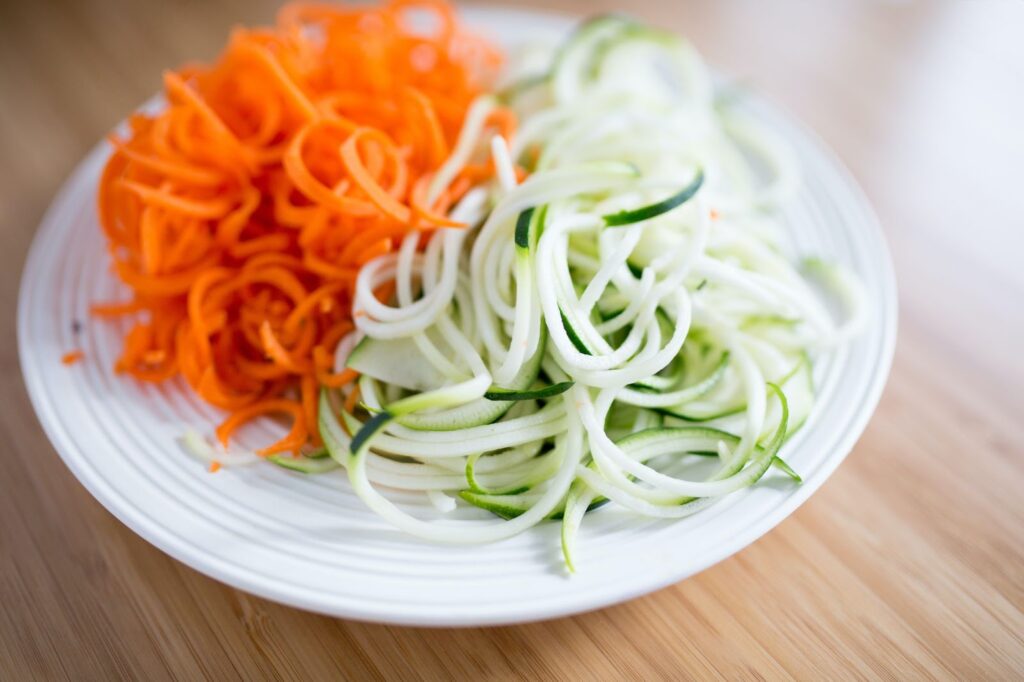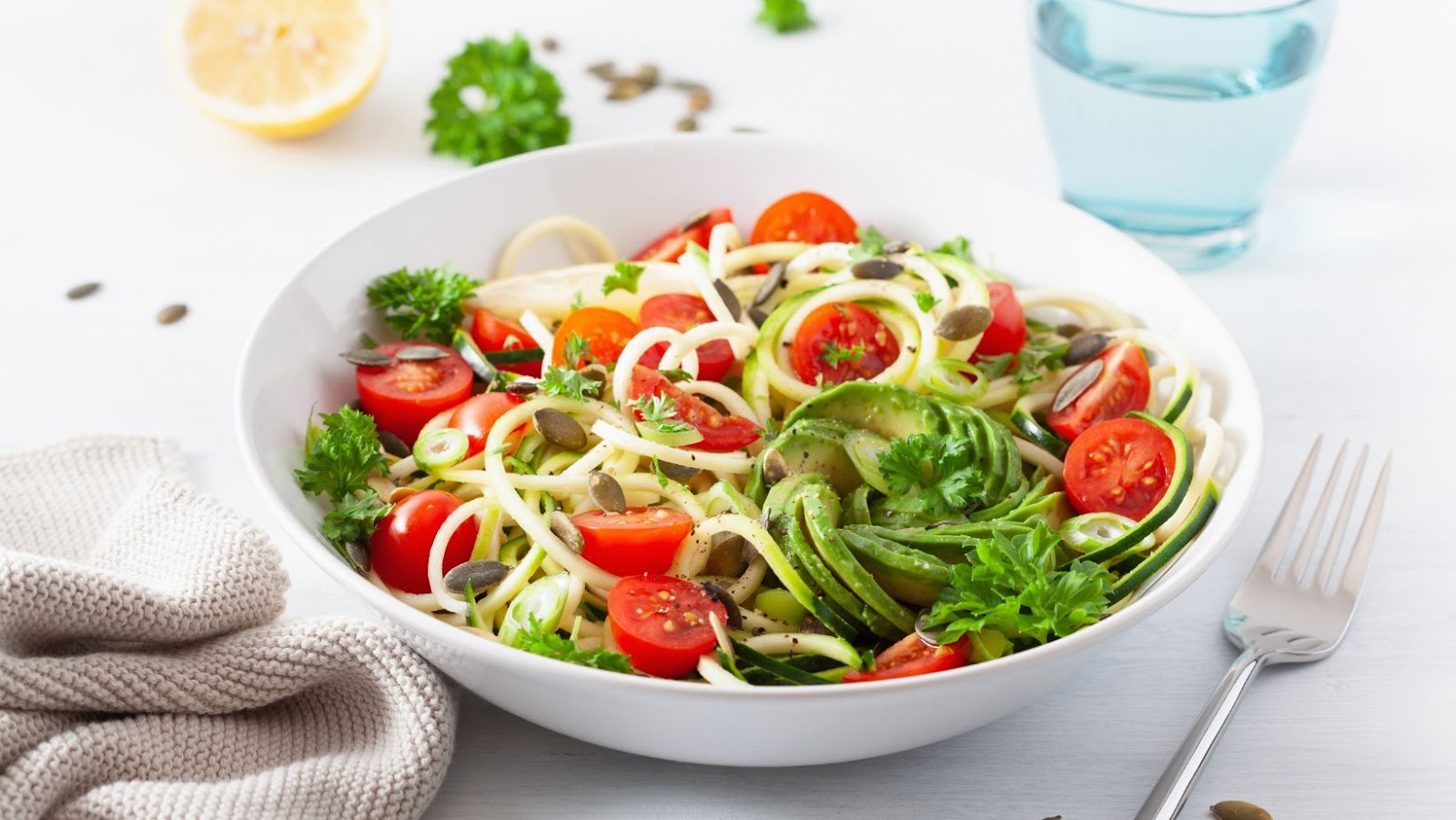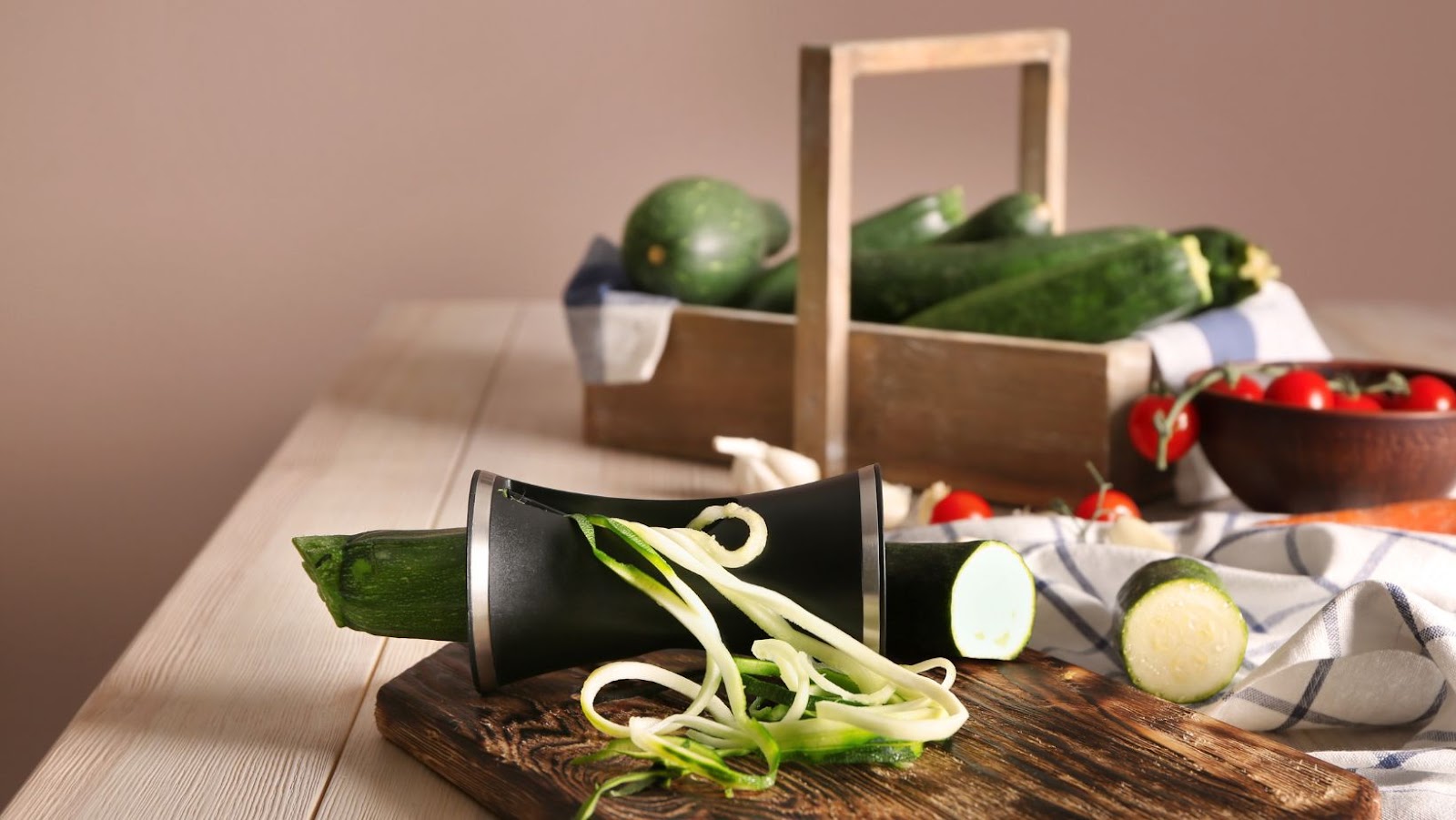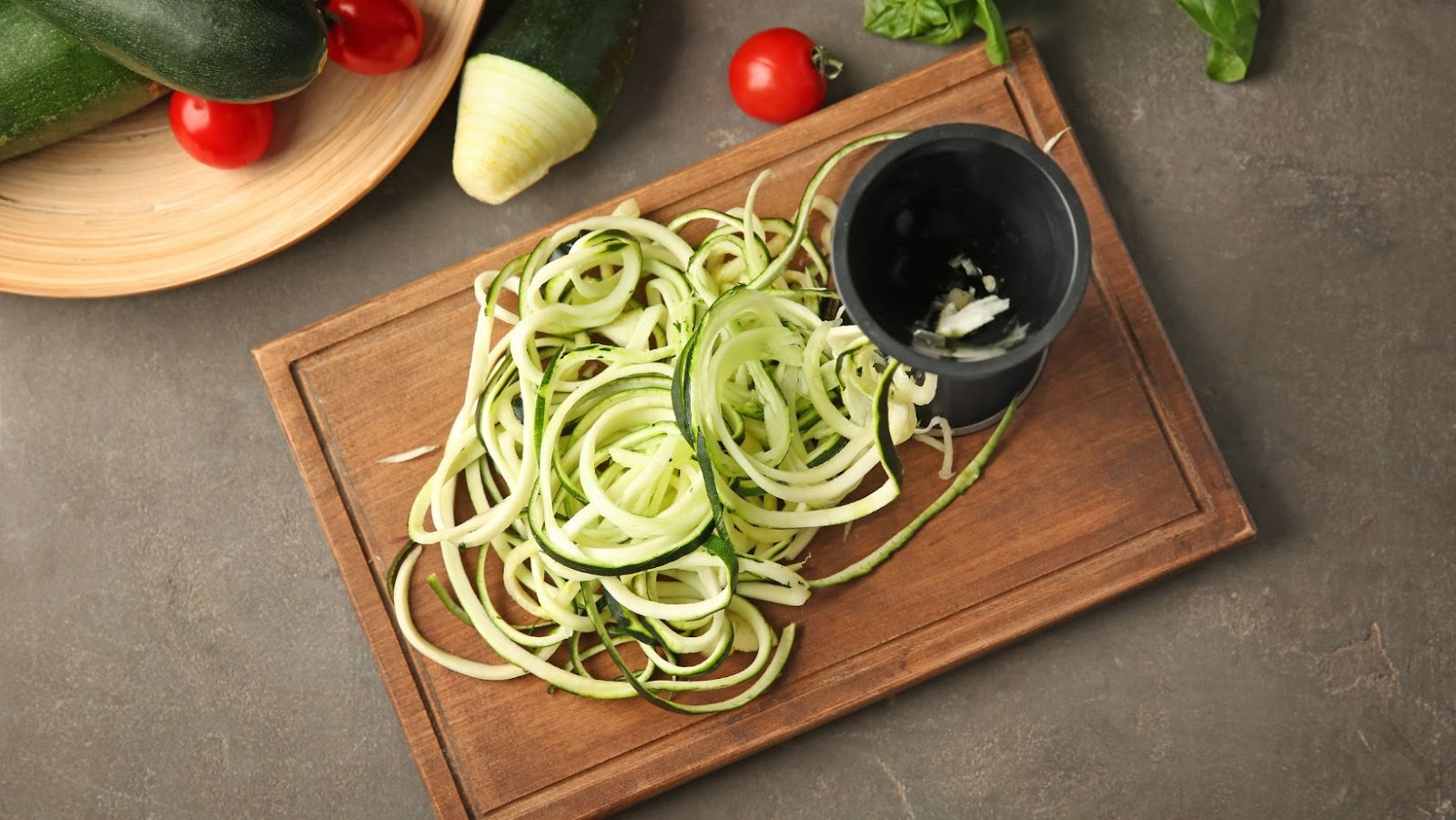
Tips For Spiralizing Zoodles
To master the art of spiralizing zoodles, you need to know the right methods. Use the spiralizing tool method, julienne peeler method, or mandoline slicer method as a solution to achieve perfect zoodles every time.
Spiralizing Tool Method
For those looking to create delicious and healthy meals, the process of turning vegetables into noodles has become increasingly popular. This technique is known as the Spiralizing Tool Method and can be accomplished in a variety of ways that we will explore below.
| Method | Description |
| Handheld Spiralizer | A simple and affordable option for spiralizing zucchinis, cucumbers, carrots, and sweet potatoes. |
| Electric Spiralizer | Efficient for larger batches of vegetables with multiple blades for varying thicknesses. |
| KitchenAid Attachment | An attachment that works with KitchenAid stand mixers for a quick and easy spiralizing experience. |
It’s important to note that each method provides different results in terms of texture and thickness. For example, handheld spiralizers produce thinner noodles than electric spiralizers. KitchenAid attachments are also a unique option for those who already own a mixer.
Interestingly enough, the concept of using spiralized vegetables as a noodle substitute traces back to traditional Japanese cooking. The dish called ‘somen’ is made by thinly slicing cucumber or daikon radish into long strands and served cold with dipping sauce.
Overall, incorporating spiralized zoodles into your diet can provide creative and tasty meal options. With various methods available, it’s easy to find one that fits your needs and budget. Be sure to pick the right spiralizer, or your zoodles may end up looking like a twisted science experiment gone wrong.
Choosing the Right Spiralizing Tool
To find the most suitable spiralizing tool for your Zoodles, follow these guidelines. First, consider the type of vegetable that will be used. Some tools are better suited for softer vegetables like zucchini while others work well with harder veggies like sweet potato. Additionally, think about the size and shape of noodles you want to create before making a purchase.
| Feature | Spiral Cutters | Handheld Spiralizers | Electric Spiralizers |
| Type of Vegetables Suited For | Soft vegetables like zucchini, cucumbers, and carrots. | A variety of vegetables including hard root vegetables. | Bulky squash and hard root vegetables like sweet potato or butternut squash. |
| Size/shape of Noodles produced | Narrow and long spiral noodles. | Varying thicknesses and shapes depending on blade attachments. | Larger noodles that resemble ribbons or fettuccine. |
It’s also important to consider the ease of use and clean up for each tool. Handheld spiralizers offer convenience while electric options require a power outlet and may take up more counter space. Although it’s tempting to opt for cheaper models, investing in a high-quality tool can make all the difference in quality of spirals produced. Interestingly, humans have been using devices similar to modern spiralizers since ancient times to create decorative food garnishes. In fact, the first written record dates back to 3rd century China where thin slices of turnips were cut into ornamental shapes. Get your veggies in a twist with the ultimate spiralizing tool – it’s a zoodle game changer!
How to Spiralize Using a Spiralizing Tool
To Make Zucchini Noodles Using a Spiralizer
Using a spiralizing tool is an easy and fun way to transform zucchinis into healthy and delicious noodles. Here’s how to do it:
- Begin by selecting a firm zucchini. Wash and dry it thoroughly.
- Cut off both ends of the zucchini, then attach it to your spiralizer according to the manufacturer’s instructions.
- Turn the crank slowly with one hand while using your other hand to guide the zucchini through the blade. Continue this motion until the entire zucchini has been turned into noodles.
For additional variations, try different blades on your spiralizing tool, which will give you thinner or wider noodles. You can also peel the zucchini before spiralizing for uniformity or leave it unpeeled for added texture.
Spiralizing tools have been around since at least 2013 when they gained popularity as a healthier alternative to traditional pasta-making methods. Today, there are many different types of spiralizers on the market, catering to various dietary needs and preferences such as handheld or electric options. Peeling your way to spaghetti-shaped sadness has never been easier with the julienne peeler method of spiralizing zoodles.

Julienne Peeler Method
For those interested in spiralizing zoodles, the method that uses a julienne peeler is an efficient and easy way to create noodles out of zucchini or other vegetables. Here is a 5-step guide to the Julienne Peeler Method:
- Choose medium-sized zucchinis with firm skin and wash them thoroughly.
- Next, use a julienne peeler to peel lengthwise strips off the green skin of the zucchini until you reach the seeds.
- Once you have enough zucchini noodles, place them in a colander and salt them well. Allow them to sit for 10-15 minutes to remove any excess water.
- Afterwards, rinse the salted zoodles under cold water and drain them again in the colander.
- Finally, pat dry with paper towels and serve as desired!
It’s important to keep in mind that using a julienne peeler will result in thin and delicate noodles compared to other spiralizing methods. If you prefer thicker noodles or are using harder vegetables like sweet potato, consider using a spiralizer instead. When using this method with softer vegetables like zucchini, it’s crucial not to press down too hard when creating each noodle. Instead, use gentle pressure and let the sharp blade do most of the work. For added flavor and color variety, consider switching up your vegetable choices! Carrots and cucumbers can also be used with this method for unique twists on classic dishes. By following these simple suggestions and techniques, anyone can successfully create delicious and healthy zoodle meals using the Julienne Peeler Method. Because let’s be real, if you’re going to spiralize zucchini into noodles, you better have the right julienne peeler or it’s just a sad, soggy mess.
Choosing the Right Julienne Peeler
When selecting a julienne peeler for spiralizing zoodles, there are several factors to consider. Here are some pointers to keep in mind:
- Look for a peeler with sharp blades that won’t get dull easily.
- Consider the handle design – make sure it is comfortable to grip and easy to hold onto as you work.
- Look for a firm and sturdy construction that can handle tougher vegetables such as sweet potatoes without bending or breaking.
- Consider the size of the peeler – larger peelers may be better suited for larger vegetables, while smaller ones may be more practical for smaller produce.
- Finally, consider the price point and your personal budget.
It’s worth noting that not all julienne peelers are created equal. Some models may be too lightweight or have flimsy blades that don’t cut through vegetables effectively. So take the time to research different brands and models before committing to one.
Interestingly, spiralizing isn’t actually a new kitchen technique; in fact, it has been popular in Asian cuisine for centuries. The traditional spiralizer was known as a “hodoyoshi” in Japan, which roughly translates to “whirlwind knife”. These early spiralizers were often made from wood or bamboo and required manual repositioning of the vegetable during cutting. It’s quite impressive how technology has advanced this technique into simple handheld devices we use today!
Get ready to strip down and julienne that zucchini like a pro.
How to Julienne Peel Zucchini
Julienning Zucchini: A Professional Guide
Julienning peel of zucchini is a popular technique in spiralizing. Here’s how you can achieve it yourself:
- Choose a ripe and firm zucchini.
- Use a julienne tool to create thin strips.
- Hold the handle, position the blade on top of the zucchini and start cutting in downward motions.
- Cut the entire zucchini until you’ve reached the seeds.
- Discard or cook seeds separately as desired.
- Collect your fresh noodles and rinse well before serving.
For variation, try slicing at an angle for wider cuts and experiment with different textures using grip pressure while cutting.
Did you know that julienning is not just limited to zucchinis? You can use this technique for other vegetables too, like carrots or cucumbers. History suggests that julienning became popular in 18th century France when chef Francois Louis Cailler accidentally discovered it while making soup for King Louis XV.
Spiralizing with a mandoline slicer – because sometimes a little danger adds flavor to your zoodles.
Mandoline Slicer Method
When it comes to preparing zucchini noodles, using a tool called the ‘Vertical Cut Slicer’ proves to be quite useful. This device is also commonly known as the ‘Mandoline Slicer.’ It is designed specifically for cutting vegetables into thin long strips.
To use the Mandoline Slicer Method, follow these simple steps:
- First, rinse and dry your zucchini.
- Next, set up your mandoline slicer on a flat surface and adjust the thickness of the blade according to your preference.
- Hold the zucchini firmly with one hand while running it down the length of the mandoline with the other hand.
- Rotate the zucchini by 90 degrees and repeat until all sides have been spiralized.
- Cut any remaining strands with kitchen scissors or a sharp knife for neatness.
It’s important to note that when operating this tool, safety precautions should be taken to avoid injuries from sharp blades. Additionally, if you desire thicker or thinner noodles, adjust accordingly before slicing.
A unique feature of slicing zoodles with a mandoline slicer is its versatility. It can create various cuts such as julienne or wavy patterned spirals. Using this method saves time, produces even results, and requires little manual effort.
Historically, Mandoline Slicers were first used over 200 years ago in France and remain popular today in kitchens worldwide due to its ease of use and efficiency in producing uniformly sliced ingredients.
Slicing through the competition to find the perfect mandoline for your zoodle needs.
Choosing the Right Mandoline Slicer
When preparing zoodles, choosing the appropriate mandoline slicer is crucial for achieving desired results. The right slicer should have adjustable blades with sharp edges to create thin and consistent noodles. It should be easy to use, clean, and store. The material and durability also play a significant role in determining the efficiency of the equipment.
A well-designed Mandoline Slicer can significantly increase productivity in terms of both time and effort. Here’s an overview of some mandoline slicers that are popularly used for spiraling zoodles:
| Product Name | Adjustable Blades | Material | Durability Rating* |
| Veggetti Spiralizer | Yes | Plastic | 3/5 |
| Oxo Good Grips Spiralizer | Yes | Plastic & Stainless steel | 4/5 |
| Spiralizer 5-Blade Vegetable Slicer | Yes | Plastic & Stainless steel | 4.5/5 |

It’s important to consider safety features like a food holder or gripper while using the slicer. Additionally, cleaning instructions should be carefully followed to ensure a longer lifespan of the equipment.
The selection of the right mandoline slicer can make all the difference in the outcome of your spiralized zoodles. With various options available in the market catering to different preferences, it’s easy to find one that suits your needs.
To fully appreciate spiraling zoodles, it is necessary to understand its rich history dating back centuries ago. It was believed that ancient cultures such as China, Greece and Italy have been consuming vegetable noodles as an alternative for traditional pasta dishes since time immemorial. The notion of spiralizing vegetables gained popularity in recent years through its health benefits and versatility in cooking.
Warning: Using a mandoline slicer to spiralize zoodles may give your fingers a new ‘zoodle’ look.
How to Spiralize Using a Mandoline Slicer
To spiralize zoodles, one can use a mandoline slicer. This tool is an efficient and quick way to create spiralized vegetables for your meals.
Here is a simple 3-step guide on how to use a mandoline slicer for spiralizing zoodles:
- First, attach the julienne blade of the mandoline slicer.
- Next, place the vegetable vertically onto the slicer and hold it with one hand while using the other hand to slide the vegetable down towards the blade.
- Finally, repeat this process until you have enough zoodles to suit your needs.
One important detail to consider when using a mandoline slicer is safety measures. Always ensure that your fingers are not near the blade as it could cause serious injury.
Incorporating spiralized vegetables into your meals has many health benefits. Don’t miss out on these nutritious and delicious zoodles – try using a mandoline slicer today! Who needs a spiralizer? Just use your ninja knife skills and you’ll have perfectly imperfect zoodles in no time.
How to Make Zoodles Without a Spiralizer
To make perfect zoodles without a spiralizing tool, try the knife method, cheese grater method, or vegetable peeler method. These techniques offer a simple solution to create the perfect zoodles even if you don’t have a spiralizer handy.
Knife Method
Slicing Method for Making Perfect Zoodles Without a Spiralizing Tool
Spiralizing your vegetables is not the only way to make delicious zoodles. With the Slicing Method, you can create perfect zucchini noodles without the need for expensive kitchen gadgets.
Here are 5 easy steps to follow:
- Cut both ends of your zucchini
- Using a sharp knife, carefully slice the zucchini lengthwise into thin strips.
- Arrange the strips in a stack and cut them into long, thin ribbons.
- For thinner noodles, use a julienne peeler or mandoline slicer.
- Once sliced, blanch the zoodles in boiling water for a minute or two before draining them completely.
For an added crunch and flavor profile, pan-fry your noodles in hot olive oil with garlic and salt—delicious!
It’s worth noting that while this may take more time than using a spiralizer, it’s still a great alternative if you don’t have access to one or want to save some space in your kitchen!
One avid home cook uses this method regularly and swears by it as an affordable and effective way to create healthy veggie noodles at home!
Don’t bring a butter knife to a zoodle fight – the right blade can make all the difference.
Choosing the Right Knife
Knives That Will Help You Achieve Perfect Zoodles
When making zoodles without a spiralizing tool, choosing the right knife is essential. Here are three points to consider when selecting a knife for your zoodles:
A sharp knife will make it easier to cut through the tough skin of the zucchini. A dull knife can crush or damage the vegetable, which would affect the final texture and appearance of your zoodles.
A long blade will allow you to make longer strokes while cutting which makes it easier to create uniform thin slices of zucchini.
Cutting vegetables requires some manual effort, so having a comfortable handle with good grip will ensure that your hand does not tire quickly and you can successfully complete making perfect zoodles.
- Choose a sharp knife:
- Choose a long blade:
- Choose a lightweight and comfortable handle:
It’s important to note that knives such as small paring knives or serrated knives should be avoided as both lack efficiency in creating uniform cuts and make it more challenging to achieve perfect zoodle texture and consistency.
Make sure you select the right knife such as Chef’s Knife or Santoku Knife, which come with sharp blades and are designed specifically for slicing vegetables.
Don’t let inefficient knives hold you back from achieving perfect zoodle texture. Selecting an appropriate cutting tool will take less time in preparation but leave enough room for innovation while cooking. Who needs a spiralizer when you’ve got a knife and a clear desire for a zoodle-induced arm workout?
How to Cut Zucchini into Zoodles Using a Knife
To achieve perfect zoodles without a spiralizing tool, you need to know the right technique for “.2 Cutting Zucchini into Noodle-Like Strips Using a Knife”. Here is a 5-Step Guide to help you out:
- Wash and dry your zucchini.
- Cut off both ends of the zucchini using a sharp knife.
- Hold one end of the zucchini with one hand and use the other hand to make long, continuous, thin strips by slicing it lengthwise.
- Repeat step three until you have created enough strips.
- Stack the strips on top of each other and cut them lengthwise again to create thinner and more noodle-like pieces.
Additionally, remember to be gentle while cutting your zucchinis to prevent breaking. Also, ensure that you remove excess water from your zoodles before cooking them.
For a unique touch that hasn’t been mentioned already, try cutting your vegetables in advance and storing them in an airtight container in the fridge. You can reach for them whenever you want as an addition to salads or smoothies.
Don’t miss out on enjoying delicious and healthy meals because you don’t have a spiralizer! Try cutting your zucchinis with this guide today. Who needs a spiralizer when you can just shred your zucchini dreams with a trusty cheese grater?
Cheese Grater Method
The Grating Technique for Zoodles
Learn how to make perfect zoodles with a cheese grater, an alternative to using a spiralizer tool. To start, wash and dry the zucchini before cutting off the ends.
- Use a box or handheld cheese grater with large holes to shred the zucchini lengthwise.
- Place the shredded zucchini in a colander or strainer and sprinkle salt on it.
- Gently mix and let it sit for at least 10 minutes to drain out excess water.
- Squeeze out any remaining moisture with paper towels.
- Proceed with your chosen recipe by sautéing, steaming, or eating raw.
- Enjoy your delicious and nutritious zoodles!
One unique detail about this technique is that grated zucchini tends to be shorter than spiralized ones, making them easier to handle if you prefer bite-sized noodles.
For an enhanced experience, consider adding delicious sauces like creamy avocado sauce or tangy tomato sauce! These suggestions work because they add flavors while also balancing out the texture of the noodles. The sauces also have nutritional benefits such as healthy fats from avocados or lycopene from tomatoes.
Grate things will happen when you choose the right cheese grater.
Choosing the Right Cheese Grater
When it comes to making zoodles without a spiralizing tool, choosing the right cheese grater is crucial. Here’s how to pick the perfect one:
- Choose a box grater with medium-sized holes for thicker, heartier zucchini noodles.
- Opt for a Microplane grater for thinner, spaghetti-like zoodles.
- Invest in a julienne peeler for a faster and more efficient process.
- If you have a mandoline slicer, use the julienne blade for consistent noodle shapes.
- When all else fails, use a sharp knife to carefully slice thin strips of zucchini into noodle shapes.
It’s essential to keep in mind that softer vegetables like zucchini can be trickier to work with than harder ones. Make sure to choose a grater that won’t shred your veggies too much before cooking them.
For an even easier method of creating zoodles without using specialized equipment altogether, try using prepackaged spiralized vegetables found at your local grocery store.
I once struggled with finding the right cheese grater when experimenting with vegetable noodles, but now that I have discovered the perfect microplane grater, my cooking game has never been stronger.
Say cheese and get ready to grate your way to perfect zoodles without a spiralizer!
How to Grate Zucchini into Zoodles Using a Cheese Grater
To create zoodles without a spiralizing tool, try grating zucchini with a cheese grater. Follow these five simple steps:
- Wash and dry the zucchini;
- Trim the ends of the zucchini;
- Rub the zucchini against the largest side of your cheese grater;
- Gently squeeze out any excess moisture from your grated zoodles; and
- Cook your zoodles in your preferred method.
It’s important to note that when using this method, you may end up with shorter and more irregular cuts of zoodles compared to those made with a spiralizer. Additionally, be sure to use a firm grip on the zucchini when grating to prevent any injury.
As with all cooking methods, there may be some trial and error involved in getting it just right. In fact, one cook shared their story about accidentally slicing their finger while using a cheese grater for zoodling. So, be careful and take some extra time to make sure you’re holding the zucchini securely before you begin grating.
Finally, a reason to use that vegetable peeler gathering dust in your drawer- it’s the secret to perfect zoodles!
Vegetable Peeler Method
If you don’t have a spiralizing tool, the “long vegetable peeler method” is an excellent option to make perfect zoodles. This method will allow you to achieve similar results as with a spiralizer, and it’s effortless. All you need is a good quality vegetable peeler, which can help you achieve long ribbon-like strands of zucchini.
To create zoodles using the Vegetable Peeler Method:
- Begin by washing your zucchini thoroughly and patting them dry
- Cut off both ends of each zucchini.
- Hold the zucchini in one hand at its base and use the vegetable peeler with the other hand to shave the zucchini lengthwise carefully.
- Continue peeling until you reach the seed center. If you accidentally peel through the skin and slice it, stop and continue on another side.
- Once all of the flesh has been shaved into ribbons, tightly gather them together and cut them into shorter even pieces or leave them whole for presentation purposes.
The Vegetable Peeler Method will work not only with zucchinis but also with carrots, cucumbers, sweet potatoes or any other veggies suitable for spiralizing. The most important thing to remember when making any type of veggie noodles without a spiralizer is to be careful while shaving so that it doesn’t break apart.
A true fact: According to Statista.com, in 2020, over 99% of US households consume vegetables regularly.
Don’t settle for a peeler that just strips the surface – go for the one that digs deep and gets to the heart of the veggie.
Choosing the Right Vegetable Peeler
Having the right tools is crucial when it comes to making perfect zoodles without a spiralizing tool. Here are some tips for selecting the ideal vegetable peeler.
- Opt for a Y-Shaped Peeler: A Y-shaped peeler is ideal for making zoodles as it allows you to control the pressure and angle while applying less force, preventing hand fatigue.
- Look for a Sharp Blade: Choosing a vegetable peeler with a sharp blade ensures that you have precise cuts and doesn’t damage the noodle-like structure of the zucchini and other vegetables.
- Check the Handle Grip: The handle grip of your vegetable peeler should be non-slippery, comfortable, and easy to grip. This will help ensure that your hands do not tire out during preparation.
- Consider Durability: Choose a high-quality vegetable peeler that is made with durable materials such as stainless steel blades to prolong its lifespan.
While selecting vegetable peelers may seem simple, choosing the right one can make all the difference in achieving perfect zoodles every time. It’s highly recommended that you put these tips into practice before starting any recipe involving zucchini or any other type of vegetables.
Using a blunt vegetable peeler can ruin your overall experience in making tasty meals from this gluten-free recipe. So always look out for quality over cost when selecting a new one to add to your kitchen tools collection.
Who needs a spiralizer when you have a trusty vegetable peeler? Time to get peeling and zoodle-making like a pro!
How to Peel Zucchini into Zoodles Using a Vegetable Peeler
Zucchini can be easily transformed into delicious zoodles without a spiralizer. The following steps will guide you on how to peel zucchini into zoodles using a vegetable peeler.
- Wash the zucchini and trim off both ends.
- Next, use a vegetable peeler to create long, thin strips of the zucchini. Peel lengthwise in one smooth motion until you reach the center of the zucchini.
- Rotate the zucchini 90 degrees and repeat Step 2 around all four sides of the zucchini until all that is left is a small core of seeds.
When peeling the zucchini make sure to apply gentle pressure so that your noodles come out thin and uniform. Overly thick or unevenly cut noodles are difficult to cook evenly.
A pro-tip for making perfect zoodles with a vegetable peeler is to use fresh, firm, and straight vegetables for easier peeling. Enjoy your newly created homemade zoodles in any recipe that calls for noodles!
Get your zoodle game on point by following these best practices – or risk ending up with a sad, soggy mess that even your dog won’t want to eat.
Best Practices for Preparing and Cooking Zoodles
To ensure that your zoodle dishes are delicious and satisfying, follow the best practices for preparing and cooking zoodles outlined in this section. With the sub-sections of soaking zoodles in salt water, squeezing out excess moisture, lightly pan frying or steaming zoodles, using zoodles in a variety of dishes, and storing zoodles correctly to extend freshness, you’ll be on your way to creating perfect zoodle dishes every time!

Soak Zoodles in Salt Water
Imprison zoodles in briny water to enhance their texture and flavor.
- Begin by washing the zoodles and placing them in a large bowl.
- Add enough salt to cover the zoodles and mix well.
- Let it soak for at least 20 minutes, then rinse thoroughly before using.
Interestingly, this process not only softens but also reinforces the structure of the vegetable strands, making them more robust during cooking.
Don’t let poorly prepared zoodles ruin your dish; opt for this easy yet essential step to achieve perfect results every time.
Don’t be afraid to really get in there and give those zoodles a good squeeze- they won’t mind, they’ve been through worse in their past lives as zucchinis.
Squeeze Out Excess Moisture
To maximize the flavor potential and texture of zoodles, it’s essential to remove any excess moisture. This step ensures that the noodles remain crunchy and distinct while cooking.
- After spiralizing the zucchini, place the noodles on a clean, absorbent kitchen towel.
- Gently press another towel on top of the noodles to soak up any excess water.
- Repeat the process with a fresh towel until no more moisture is visible.
- If you have time, let the noodles sit for 10-15 minutes to allow any remaining liquid to evaporate.
- Dabbing or rubbing paper towels on individual pieces is also an effective way to remove excess water.
It’s worth noting that removing too much water can leave your dish dry. Strive for optimal moisture balance by testing the texture throughout the cooking process. For best results, use fresh zucchini without bruising or soft spots. Ensuring your vegetable is as dry as possible before cooking maximizes its flavor potential. Pro Tip: Sprinkle a pinch of salt onto your zoodles before squeezing out excess moisture. This technique enhances their flavor while helping them release even more liquid. Get ready to take your love for pasta to a whole new level with zoodles – lightly pan fry or steam them to create a dish that’s both healthy and delicious!
Lightly Pan Fry or Steam Zoodles
To cook zoodles, lightly sauté or steam them to retain their texture and nutrition. Here’s a six-step guide to prepare them:
- Clean the zucchini and cut off the ends.
- Using a spiralizer, cut the zucchini into thin noodle-like strands.
- In a non-stick pan, heat oil over medium-high flame.
- Add minced garlic and sauté for 30 seconds before adding in the zoodles.
- Sauté the zoodles for 2-3 minutes until they turn soft but still have some crunch.
- Add salt and your choice of seasoning before serving hot.
For something more unique, try flambéing zoodles with some brandy or cognac. This adds depth to flavor and an excellent twist to your taste buds.
Pro tip: To avoid sogginess while cooking, sprinkle salt over the prepared zoodles beforehand and let sit for 10-15 minutes before patting dry with paper towels.
Say goodbye to boring meals and hello to zoodle-infused dishes that will make your taste buds dance.
Use Zoodles in a Variety of Dishes
Zoodles, or zucchini noodles, are versatile and can be used in many dishes beyond just replacing traditional pasta. Here are some ways to incorporate them into a variety of meals:
- As a base for stir-fries
- In place of spaghetti in marinara sauce
- In salads for added crunch and flavor
- As a substitute for noodles in soups or Asian-inspired dishes
Perhaps the best part about zoodles is their ability to absorb flavors, making them perfect in a range of cuisines. Additionally, they are low-calorie and nutrient-dense compared to their carb-heavy counterparts.
To uplevel your zoodle game, try spiralizing other vegetables like carrots or sweet potatoes for added texture. The possibilities are endless!
A friend once shared how hesitant she was to try zoodles until she finally did and ended up loving them. It goes to show that sometimes stepping outside of our comfort zones can lead to surprisingly delicious results.
Who knew that treating zoodles like a delicate bouquet of flowers could actually prolong their shelf life?
Store Zoodles Correctly to Extend Freshness
To maintain the freshness of your zoodles, proper storage is crucial. Here’s how you can store zoodles correctly to extend their shelf life:
- After spiralizing, pat dry the zoodles with a cloth or paper towel to remove excess moisture.
- Store the zoodles in an airtight container and place them in the refrigerator.
- Zoodles can be stored for up to 5 days in the refrigerator.
- To freeze zoodles, place them on a baking sheet lined with parchment paper and freeze for an hour. Afterwards, transfer the frozen zoodles to a freezer-safe bag or container and store for up to 6 months.
It’s important not to wash your zoodles until you’re ready to use them as this can cause them to spoil quickly. Additionally, avoid storing cooked and uncooked zoodles together as this can make them mushy and reduce their shelf life.
Keeping your zoodles fresh doesn’t have to be difficult. By following these simple steps, you’ll be able to enjoy your healthy and delicious meals without worrying about spoiled vegetables.
A study by Research And Markets found that the global demand for vegetable-based pasta is expected to grow at a CAGR of 4.5% from 2018 – 2022.






